
Tire Tips and Tricks
Front and Rear Tire Matching

Remember, correct matching of front and rear tires is important to obtain
optimum performance and handling. Follow the Tire Selection guidelines.
Mount only tires marked “front wheel” on front positions and only
tires marked “rear wheel” on rear positions.
A new front tire with a worn rear tire can cause instability.
Mixing radials, or mixing radials with bias or belted bias tires may adversely
affect handling and stability. Always fit Dunlop Sportmax, Sportmax II D204,
Sportmax touring D205 and Dunlop D207 high-performance radials in pairs. It
should be noted that many factors other than tire incompatibility can affect
the handling of a motorcycle, including the weight and height of the rider,
mixing worn with unworn tires, and the fitment of luggage or fairings. Consult
the motorcycle manufacturer before making modifications from stock.
Maintaining Clearance
Consult the motorcycle manufacturer if you intend to mount sizes other than
indicated in the owner's manual. Remember the tire's physical dimensions are
important. Adequate clearance of fenders, swingarm, etc., must be maintained.
Increasing tire size may require an increase in rim width. When increasing
tire size and/or rim width, rotate wheel and inspect closely for sufficient
clearance.
Tubes
Tubes are a crucial part of the tube-type wheel assembly. They should be treated
with respect. When fitting a new tire on a rim requiring a tube, a new tube
should be fitted at the same time. Old tubes become stretched and if an old
tube is fitted within a new tire, it can crease and fail due to thinning of
the tube rubber. Tubes should be repaired only by an expert. Secure tube valve
assembly to rim with care. Inspect rim band and consult motorcycle dealer
for correct rim band replacement. Always check the size markings on the tube
to assure that the tire size appears on the tube. Do not fit tubes in radial
motorcycle tires, nor fit radials on rims requiring tubes, unless the tubes
bear matching size and radial (R) markings.
Tire Pressures (see also Tire Mounting)
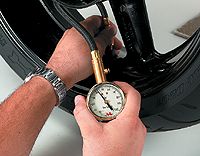
Follow pressure recommendations shown on the Motorcycle Tire Application Guide.
Contact manufacturer if year and model are not shown on the current guide
and the owner's manual does not list pressure settings for your tires. Keep
in mind that hard cornering, passengers, heavy loads and sustained high speeds
will require higher pressures (up to that indicated on the sidewall).
CHECKING TIRE PRESSURES IS THE MOST IMPORTANT TIRE MAINTENANCE FUNCTION YOU CAN PERFORM.
For high-speed, fully loaded or dual-riding touring motorcycle applications, inflate front tires to maximum recommended by vehicle manufacturer for fitment and rear tires to maximum load inflation pressure on sidewall. Rear touring tires must be inflated to a minimum of 36 psi for light to medium loads and 40 psi for dual riding and other loads. Never exceed maximum load indicated on tire sidewall or vehicle capacity load found in owner's manual. Underinflated tires can result in imprecise cornering, higher running temperatures, irregular tread wear at the edge of the contact patch, fatigue cracking, overstressing and eventual failure of the tire carcass. Overinflating tires does not increase load carrying capacity, but will result in a hard ride and accelerated tire wear in the center of the contact patch. Check cold tire pressure frequently with a good quality gauge that holds a reading, and always before extended trips. Loss of pressure may occur due to worn out or badly seated valve cores. Check valve cores. If necessary, tighten for correct seating, or remove and replace them. A metal or hard plastic valve cap with an inner gasket should be used and installed finger tight to protect the valve core from dust, moisture and to help maintain a positive air seal. Repeated loss of inflation pressure may result from undetected tire damage. Visually inspect tires for punctures, cuts, abrasions, cracks, bulges, blisters or knots. It will be necessary to dismount the tire to complete an inspection for internal damage and any need for repair. See the Tire Repair section. Only certain punctures in the tread area may be repaired, and only if no other damage is present. Tires with non-repairable damage must not be used again. Damage caused by impacts, penetrations or continued underinflated/overloaded use is progressive and can result in sudden and complete tire failure and accident. Always seek expert inspection of the dismounted tire following curb, chuckhole or other impacts, evidence of penetration beyond the tire surface, bulges or low pressure. Do not continue riding on such tires. Inspect your tires frequently for damage and always heed warning signs such as vibration, handling instability, rubbing or tire noise that occurs during operation of the motorcycle.
Speed Ratings
S, H, V, and Z ratings where applied are indicative of high-performance capability
based on indoor wheel testing and are not valid for damaged, altered, repaired,
excessively worn, underinflated or overloaded tires. It is not recommend to
use of any tire products in excess of legal speed limits. Consult the owners'
manual for recommended speed rating and do not mix ratings front to rear.
Run-in Period
Replacements for worn, differently patterned or constructed tires will not
react the same. When new tires are fitted, they should not be subjected to
maximum power, abrupt lean-over or hard cornering until a reasonable run-in
distance of approximately 100 miles has been covered. This will permit the
rider to become accustomed to the feel of the new tires or tire combination,
find the edge, and achieve optimum road grip for a range of speeds, acceleration
and handling use. Check and adjust inflation pressure to recommended levels
after tire cools for at least three (3) hours following run-in. Remember,
new tires will have a very different contact patch and lean-over edge. New
tires, mixing a new tire with a worn older tire, and mixing different pattern
combinations require careful ride evaluation.
Wheel Balance
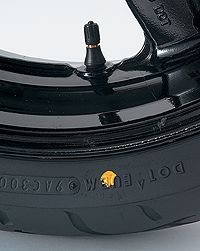
It is essential tire/wheel assemblies be balanced before use and rebalanced
each time the tire is removed or replaced. Unbalanced tire/wheel assemblies
can vibrate at certain speeds, and tire wear will be greatly accelerated.
All street tires should be installed with the yellow balance dot at the valve.
Wheels may be balanced with spoke nipple weights, lead wire or self-adhesive
rim weights. Consult the motorcycle manufacturer for approved wheel weights.It
is not recommend that you use dry or liquid balancers/sealers and will not
warrant tires into which these materials have been injected. Tire and wheel
assembly balance must be checked with a balance stand or computer wheel balancer.
Replace immediately any broken spokes and tighten any loose ones. Broken spokes
transfer additional tension to adjoining spokes, creating the potential for
further spoke failures. After tightening or replacing spokes, be sure that
the wheel rims run true. Inspect the rim, rim band and tube, and replace any
of these components if they are damaged before refitting the tire. Both broken
and loose spokes may cause wheel wobble, thus accelerating tire wear, and
could cause instability.
Tube-Type Rims
Note: Not all cast wheels, whether aluminum or magnesium, are suitable for
tubeless tire fitment. Mount tires as tubeless only when the wheel manufacturer
recommends it. Some spokeless rims require tubes. With a tube inserted,
a tubeless tire may be fitted to a tube-type wheel. Exception: Tier manufacturers
do not recommend fitment of non-radial tubes in radial tires. Ensure that
tube markings match radial tire markings before fitting to rims requiring
tubes.
The treatment that tires receive during extended periods of inactivity may
directly affect their mileage and performance.
Tires stored in direct sunlight for long periods of time will harden and age
more quickly than those kept in a dark or dimly lit area.
Prolonged contact with oil or gasoline causes contamination of the rubber
compound, making the tire unsuitable for use. Wipe off any oil or gasoline
immediately with a clean rag. Do not use any tire that has been exposed to
oil, gasoline, corrosives or non-rubber compatible liquids.
Safety note: 22 psi front and 22 psi rear are minimum pressures for dual-sport
highway use. Pressures for dual-sport use must be increased to pressures specified
by the motorcycle manufacturer for highway use.
It is recommended that only permanent repairs performed from
the inside of the tire, using a combination patch/plug method. Never attempt
a repair from the outside, or inject a sealant, or simply use an innertube,
a patch or a plug as a substitute for a proper repair. Only a qualified tire
repair shop or motorcycle tire dealer should perform repairs. Inspection of
the tire and adequacy of repair becomes the responsibility of the person actually
performing the repair and manufacturers do not warrant the results of a repair
in any way. Combination patch/plug repair kits for use by the repair shop
or dealer are available with accompanying instructions from companies such
as:
Remarco Inc.
200 Paris Ave.
Northvale, NJ 07647
(201) 768-8100
Technical Rubber Co.
P.O. Box 486
Johnstown, OH 43031
(740) 967-9015
Tip-Top/Moto Combi Kit
Tech Uni-Seal® Repair Kit (Also has been marketed by Honda,
Kawasaki, and Yamaha with their own part numbers.)
NOTE: There may be suitable repair kits and materials provided by manufacturers
other than those listed above.
Before any repair should be attempted, however, a tire must be removed from the wheel and thoroughly inspected. The following are minimum guidelines for the repairer:
Tires should not be repaired if any of the following conditions
exist:
A tire has been previously injected with a sealant/balancer.
The puncture is larger than 6mm (1/4") in diameter.
The puncture is not perpendicular to the carcass.
The puncture is in the tire sidewall.
Separation of plies, tread separation, separation of any other components.
Cut or broken ply cords.
Broken or damaged bead wires.
Cut or damaged chafers (bead area).
Deterioration of the carcass inside the tire due to "run flat" or
underinflation.
Cracks or other damage to the integrity of the inner liner.
Excessive wear - tire should have at least 1/32 of an inch of tread depth,
excluding tread wear indicators.
Cracks in sidewall or tread.
Impact breaks, cuts, snags or gouges that penetrate the surface.
NOTE: There should be no more than one repair in any quarter of the
tire and no more than two repairs per tire.
The wheel itself must be in good condition. Any cracked or bent wheel, however
slightly, may allow the loss of air and cause subsequent deflation of the
tire.
Following repair, the valve assembly should be replaced and the tire/wheel
rebalanced.
Speed should not exceed 50 mph for the first 24 hours after tire repair and
the repaired tire should never be used at speeds over 80 mph. The repairer
is solely responsible for instructing the motorcyclist as to the restrictions
to be placed on tire use following repair.
In summary, NO form of temporary repair should be attempted. Motorcycle tire
repairs leave no room for error and any doubt as to inspection or adequacy
of repair should be resolved by discarding the tire.
Be sure to consult our Motorcycle Tire Limited Warranty, Care
and Maintenance brochure for additional information regarding the use of your
tires. Seek a qualified motorcycle tire repair center for more details. NEVER
ATTEMPT TO REPAIR A DAMAGED TIRE WITHOUT THE AIDE OF AN EXPERIENCED TIRE MECHANIC.
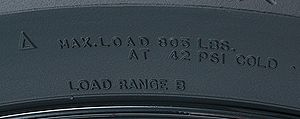
Tires offering different load-carrying capacities are available. Consider
carefully the weight of the motorcycle, the weight of any optional equipment
and whether it will carry passengers. Remember, the load- carrying capability
of the tires is also reduced by underinflation. It is possible to overload
a tire even though it is the size specified by the motorcycle manufacturer.
Maximum loads and corresponding pressures are indicated on the sidewall of
all street tires. Never exceed the accessory restrictions and vehicle load
capacity found in the motorcycle owner's manual, or the maximum load molded
on the tire sidewall. Before a trip, be sure to determine the total weight
of luggage, equipment, and rider(s) to be added to the motorcycle. Trailers
may contribute to motorcycle instability, grossly exaggerated tire
stresses and overload. Such stresses and overload can cause irreversible damage
resulting in sudden tire failure and accident. Manufacturers do not recommend
the use of trailers, nor warrants tires used on motorcycles fitted with trailers.
Sidecars should not be fitted unless approved by the motorcycle manufacturer.
Consult the tire manufacturer Technical Data Chart or the manufacturer to
ensure that the tires you select are correct for the rims. Correct rim width
may be crucial to handling and stability. A tire that is installed on a rim
wider than recommended will have a flattened profile, and a rider may easily
reach the edge of the tread during cornering. A narrow rim will alter the
tire profile, concentrating tire wear in a very small area during cornering,
with a smaller contact patch during braking. Remember: Tire clearances are
important. Fitment to Harley-Davidson 18-inch and 19-inch CM contour rims
may result in slippage or air loss. Harley-Davidson 18-inch and 19-inch CM
contour rims are not compatible with Dunlop tires. Consult Dunlop if in doubt
and before fitting tires to pre-1980 Harley-Davidson motorcycles.

Street tires have yellow balance dots in the bead or sidewall area to indicate
the lightest point of the tire. Street tires should be installed with these
balance dots at the valve. Street tires also have arrows on the sidewall,
which indicate the correct direction of rotation. Positioning of balance marks
and inclusion of directional arrows are not universal among motorcycle tire
manufacturers.
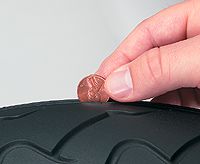
Excessively worn tires are more susceptible to penetrations. Always remove
tires from service before they reach the tread wear indicator bars (1/32 of
an inch tread pattern depth remaining). Worn/unworn tire combinations and
worn tires used in wet conditions can result in deteriorated handling.
Never put a tire in use that has been subjected to on-the-motorcycle dynamometer
engine testing. This severe use of the tire may result in tread compound degradation
and subsequent failure.
Some punctures in motorcycle tires may be repaired. Most tire manufacturers
recommend only permanent plug-patch repairs of small (maximum 1/4-inch diameter)
tread area punctures from within the dismounted tire by a qualified tire repair
shop or motorcycle dealer. Never perform an exterior repair and never use
an inner tube as a substitute for a proper repair. Speed should not exceed
50 mph for the first 24 hours after repair and the repaired tire should never
be used over 75 mph. Check inflation pressure after tire cools for at least
three (3) hours following run-in, or sooner if air loss is suspected. No form
of temporary repair should be attempted because secondary damage caused by
a penetrating object may not be detected and tire or tube deflation may occur
at a later date. Most manufacturers do not recommend the use of liquid sealants.
These are a form of temporary repair, and they may adversely affect ply material
and mask secondary damage caused by a penetrating object. Reliance upon sealants
can result in sudden tire failure and accident.
All tire manufacturers strongly recommend regular inspection of the motorcycle
generally, and of wheels in particular, because tire mileage and performance
are adversely affected by a poorly maintained vehicle. Take your motorcycles
in to the motorcycle dealer for regular maintenance checks, inclusive of tire
inspections. Maintain suspension settings in strict compliance with the vehicle
owner's manual. Improperly maintained components and incorrect or unbalanced
front fork pressures will affect stability. Low suspension pressure will generate
excessive tire stresses.
Be sure to align the wheels each time the rear wheel is removed or the chain
or belt is adjusted. Each revolution of an incorrectly aligned wheel can scuff
off tread rubber, reduce tire mileage, and impair steering and cornering.
Bent wheel rims and bent or cracked cast wheels should be replaced immediately.
Bent rims may cause wheel wobble, bead unseating and, in the case of tubeless
tires, gradual air loss. Sudden wheel failure may result from the use of cracked
cast wheels. Be aware of these conditions and their consequences.
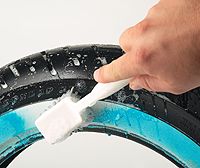
Use a mild soap solution to clean sidewalls, white striping or lettering,
and rinse off with plain water. Never apply any other material, cleaners or
dressings, to enhance sidewall appearance. These may degrade rubber and remove
inherent ozone cracking/weather checking resistance.
Try to avoid frequent and varied extremes of temperature during storage. Do
not keep tires next to radiators or sources of heat. Tires subjected to these
conditions will age more quickly than those stored in a cool, constant environment.
Do not store tires where electric motors are present. The high concentration
of ozone will accelerate tire aging.

Danger: Only specially trained persons should mount tires. Improper mounting
can cause tire explosion and serious injury.
Follow these mounting precautions:
Wear approved eye protection.
Clean and lubricate beads and rim.
Centralize rim band and tube to prevent pinching if tube-type rim.
*Note directional arrows on sidewall where applicable.
Lock assembly on mounting machine or place in safety cage before inflating
to seat beads.
Set air hose relief valve at 40 psi.
Use extension gauge and hose with clip-on air chuck. Stand back with no part
of your body within the perimeter of the assembled tire and rim.
Inflate with core in valve stem.
Never inflate above 40 psi to seat beads.*
Spin wheel to check bead seating and alignment.
*If the beads do not seat by 40 psi, deflate and repeat above procedures.
Never use a volatile substance or rubber "donut" to aid bead seating.
If the tire is a tube-type, deflate and reinflate after seating to prevent
tube wrinkles.
For 15-inch motorcycle replacement tires, never mount on a 15-inch diameter
passenger car tire rim. Mount only on a 15 M/C motorcycle rim. These passenger
car and motorcycle rims actually differ in diameter.
Never mount passenger car tires on motorcycle rims.
D402 PT bead lock tires may only be mounted on matching Harley-Davidson FXRP,
FLHTP or FLHP rims. Consult your owner's manual and see special tread label
mounting instructions.
Air pressure: Always maintain the recommended tire pressure for the type of
terrain on which the motorcycle is being ridden; check the owner's manual.
Underinflated tires may cause wheel damage when ridden in rocky, rough terrain
and allow the motorcycle to squirm or wander on smooth, hard terrains. Overinflation
may damage the tires and cause an unnecessarily harsh ride. To accurately
measure tire pressure, use a standard tire pressure gauge. Condition: Check
for cuts and gouges that may cause air leakage. Also check the tires for missing
knobs and excessively worn tread. Wheels: To avoid loss of control or injury,
make sure axle nuts are tight and secured. Grasp each tire at the front and
rear and try to rock it on its axle to detect worn-out bearings or loose nuts.
There should be no free play or slip as you rock the wheel. Inspect wheels
for broken or loose spokes and for cracks on the hub or rim.
Many manufacturers continue to be concerned about the lack of attention paid
by many cyclists to proper use and maintenance of their tires, particularly
when fitted to motorcycles intended for touring. Technical personnel have
attended touring rallies all over North America to collect vital data and
give instructional seminars.
What we have observed at these rallies alarms us; many touring riders are not following proper tire maintenance procedures. The requirements for proper tire usage are not complicated, but they do require consistent attention. Owners and operators of motorcycles should closely monitor vehicle loadings to insure they are within the maximum loads and corresponding inflation pressures for their tires. This basic load and pressure information is clearly stamped on the tire sidewalls. The tire does not support the load-the air pressure does. The manufacturer's ratings for the maximum load and inflation pressure are critical tire design elements. If not observed, the handling and performance of your motorcycle will be greatly affected.
We have checked inflation pressures at several touring rallies and found a high percentage of rear tires to be underinflated. In addition, weight checks of the rear axles of these motorcycles indicated a number of tires were loaded beyond maximum capacity. Our inspections have not been limited to those cycles fitted with Dunlop tires; the situation exists for all brands of tires. Regardless of the make of tire, this is a serious problem. Riders of motorcycles with significantly underinflated and overloaded tires will experience handling and steering difficulty. In addition, this abuse will result in disappointing premature tire wear and may cause catastrophic tire failure.
The addition of accessories, cargo, and dual riding to touring motorcycles aggravates the problems of overloading and underinflation. The excessive flexing that results from underinflation or overload causes buildup of internal heat, fatigue cracking and eventual carcass breakup resulting in complete failure. A consequence of such failure may be an accident with serious personal injury or death. The appearance of stress cracks in the tread grooves is one indicator of overload and/or underinflation. If you find evidence of tread groove cracking, you should remove and replace the tire immediately. This damage is permanent and non-repairable.
Our inspection of tires of various style and manufacture at rallies and our subsequent testing have confirmed that underinflation (and/or excessive load) causes tread groove cracking and can result in more serious damage within the tire body. Uneven wear may also accompany underinflated use. Failure to heed these visual warnings can result in tire failure or blowout.
The use of trailers can also contribute to tire damage and touring motorcycle instability. Although most motorcycle manufacturers recommend against their use, a percentage of the motorcycles we have inspected were so equipped. The trailer tongue weight added to an already heavily laden motorcycle can fail a rear tire. The percentage of overloaded motorcycle rear tires found during our inspection would have been higher if trailer tongue weight had been considered. The forces of rapid acceleration and deceleration may also multiply the effects of trailer tongue weight.
To get the maximum safe use out of your tires and maximum touring
enjoyment you should:
Properly maintain all aspects of your vehicle in accordance with manufacturer's
recommendations. Read and reread your motorcycle owner's manual.
Never exceed the loading and accessories restrictions found in your motorcycle
owner's manual, or the maximum load displayed on the tire sidewalls. Know
your loaded vehicle weight!
Check air pressure at frequent, regular intervals, particularly just before
and during long trips. Always use an accurate tire gauge* and check pressures
only when the tires are cold (i.e., wait one hour after running). We have
found many cheap gauges to be off more than 5 psi, so be sure to use a top
quality gauge and preferably one that retains the pressure reading until reset!
Inspect your tires as often as possible. Look for irregular wear, any signs
of cracking in the sidewalls and tread, blisters, knots, cuts or punctures.
Immediately remove and replace damaged tires.
If in doubt, ask your motorcycle tire dealer to check your loading, inflation
and tires. Remember, your tires stand between you and a serious accident.
For touring motorcycle loading,
follow these general guidelines:
Light loads-single rider with some luggage (up to 200 lb. total)-minimum tire
pressure of 32 psi front and 36 psi rear must be maintained.
Heavier loads-dual riding and/or luggage (from 200 lb. total up to maximum
motorcycle capacity stated in the owner's manual)-pressure of 36 psi front
and 40 psi rear must be maintained.
Please Note:
For any dual riding or fully loaded use, 40
psi must be maintained in all rear tires fitted to touring motorcycles.
In addition to following these recommendations, notice what your tires are telling you while you're riding. If your steering response is slow or mushy, or if cornering and braking response is heavy, there's a good chance your tires are underinflated. Vibration or wobble may signal that actual tire damage has occurred and failure is imminent!
If you conscientiously follow our recommendations, you will
enjoy better, longer, and safer tire performance and many, many miles of touring
pleasure.
Wednesday, June 18, 2014 22:17
